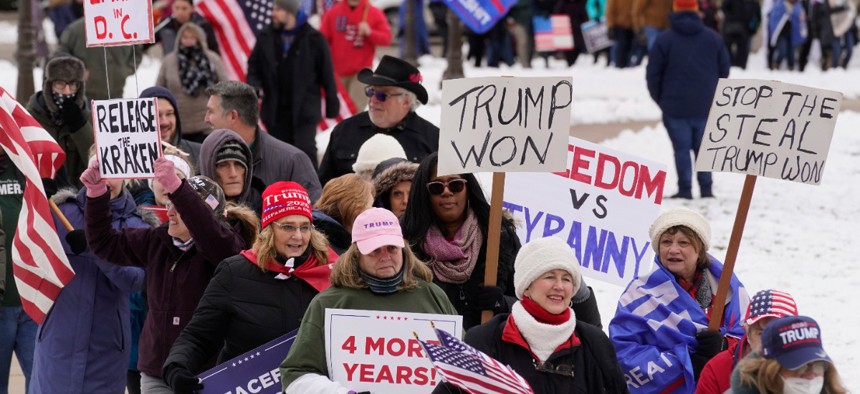As Rioters Storm U.S. Capitol, States See Protests

People attend a rally in support of President Donald Trump at the State Capitol in Lansing, Mich., Wednesday, Jan. 6, 2021. AP Photo/Paul Sancya
A crowd of President Trump's supporters forced their way into the U.S. Capitol on Wednesday. Protests at statehouses remained less volatile.
As a mob of President Trump’s supporters broke into the U.S. Capitol on Wednesday, state capitals across the country saw so-called “Stop the Steal” protests, driven by baseless claims of election fraud that the president has promoted in recent weeks.
The state gatherings were largely organized on Facebook and Parler, a social media website used by conspiracy theorists and extremists. As of Wednesday evening, none of the protests at the state level had turned nearly as violent or chaotic as what happened in D.C.
In Salem, Oregon, protesters burned an effigy of Gov. Kate Brown. Trump supporters and others who gathered there mid-day were later met by counter-protestors. The two sides clashed and police declared the situation an unlawful assembly. Oregon State Police confirmed at least one arrest for harassment and disorderly conduct.
Pro-Trump demonstrators also gathered in Washington’s state capital, Olympia. A crowd assembled in the afternoon at the Capitol campus, some waving American flags and others Trump flags.
Video posted online by multiple reporters at the scene in Olympia and a news outlet showed a group at one point breaching a gate and entering the governor's mansion grounds. Police moved in, ordered them to disperse and eventually cleared people from the area.
Gov. Jay Inslee, a Democrat, said later in the evening that he and his wife were doing "just fine."
“I revile these acts of sedition and intimidation that we've seen in our nation today," he added.
Meanwhile, a journalist for The Olympian covering the event reported that a man with a gun directed a death threat at her and other members of the media. There was gunfire at two political protests in Olympia last month, wounding at least one person.
Although most of the state protests around the country Wednesday stayed outside, protesters did enter at least two capitol buildings.
In Kansas, news station KSNT reported a crowd in the rotunda remained peaceful and broke up within a few hours. The protesters were allowed in due to inclement weather, according to the Kansas Highway Patrol's Capitol Police.
Protesters also entered the Iowa Capitol building where they chanted “hold the line” and “drain the swamp.”
As the situation in D.C. became more intense, some state and local officials chose to clear out of government buildings.
The New Mexico state House speaker ordered the evacuation of the Capitol building during a Legislative Council meeting.
Georgia Secretary of State Brad Raffensperger, who Trump pressured to change the results of the election in his state, left with his staff from their offices when armed protesters arrived at the Capitol.
The Republican governor of Georgia, Brian Kemp, called the events at the U.S. Capitol "a disgrace and quite honestly un-American." He said he'd extend an executive order activating the state's National Guard and that he had been discussing safety measures with lawmakers for the state's upcoming legislative session, which starts Monday.
"We have to come together in this state and in this country," he added.
In Texas, the Department of Public Safety closed the state Capitol grounds just before 2 p.m., with the agency saying it did so “out of an abundance of caution” as dozens of protesters gathered in Austin.
Denver Mayor Michael Hancock ordered city agencies to close municipal buildings early for the day, saying that about 700 people had gathered downtown near the Colorado state Capitol. But as of mid-afternoon there were no reports there of major unrest.
Demonstrators in Arizona set up a guillotine outside the state Capitol, mirroring a similar display outside the U.S. Capitol building in D.C.
Minnesota State Police put up barriers and blockades around the statehouse. Rhode Island increased police presence at its Capitol, too.
Trump supporters in Ohio were met by counter-protesters. Members of the far-right white nationalist organization Proud Boys briefly clashed with anti-Trump protesters in Columbus.
DeJuan Sharp, an anti-Trump protester, told The Columbus Dispatch it was hypocritical police were not firing tear gas on the Proud Boys as they had on Black Lives Matter protesters who came to the capital in June following the death of George Floyd.
Protest activity also occurred Wednesday in the capitals of Arkansas, Michigan, Nevada, and Utah, among other places.
By around 6 p.m., officials announced that the U.S. Capitol was secure. Congressional lawmakers later reconvened to resume the process of counting electoral votes that had been disrupted by the earlier siege.
This story has been updated with additional information.
Emma Coleman is the assistant editor for Route Fifty. Bill Lucia is a Senior Reporter for Route Fifty.
NEXT STORY: New Hampshire Sued Over Treatment of Foster Youth with Mental Health Issues





